light PORSCHE 911 CARRERA 2011 5.G Information Manual
[x] Cancel search | Manufacturer: PORSCHE, Model Year: 2011, Model line: 911 CARRERA, Model: PORSCHE 911 CARRERA 2011 5.GPages: 67, PDF Size: 9.93 MB
Page 4 of 67
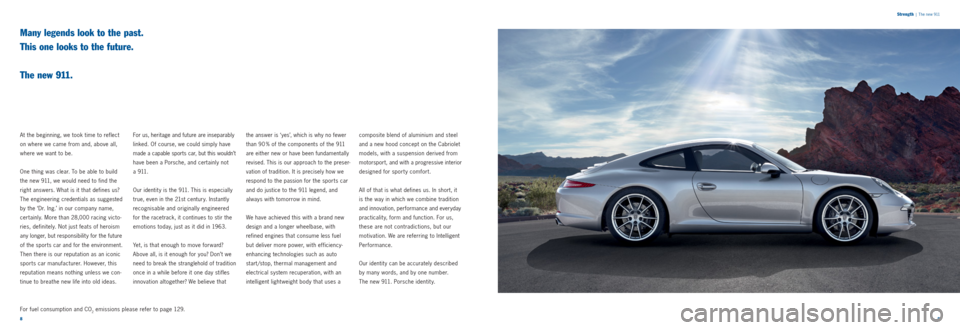
89
Many legends look to the past.
This one looks to the future.
The new 911.
At the beginning, we took time to reflect
on where we came from and, above all,
where we want to be.
One thing was clear. To be able to build
the new 911, we would need to find the
right answers. What is it that defines us?
The engineering credentials as suggested
by the ‘Dr. Ing.’ in our company name,
certainly. More than 28,000 racing victo -
ries, definitely. Not just feats of heroism
any longer, but responsibilit y for the future
of the sports car and for the environment.
Then there is our reputation as an iconic
sports car manufacturer. However, this
reputation means nothing unless we con -
tinue to breathe new life into old ideas. For us, heritage and future are inseparably
linked. Of course, we could simply have
made a capable sports car, but this wouldn’t
have been a Porsche, and certainly not
a 9 11 .
Our identit y is the 911. This is especially
true, even in the 21st century. Instantly
recognisable and originally engineered
for the racetrack, it continues to stir the
emotions today, just as it did in 1963.
Yet, is that enough to move forward?
Above all, is it enough for you? Don’t we
need to break the stranglehold of tradition
once in a while before it one day stifles
innovation altogether? We believe that
the answer is ‘yes’, which is why no fewer
than 90 % of the components of the 911
are either new or have been fundamentally
revised. This is our approach to the preser -
vation of tradition. It is precisely how we
respond to the passion for the sports car
and do justice to the 911 legend, and
always with tomorrow in mind.
We have achieved this with a brand new
design and a longer wheelbase, with
refined engines that consume less fuel
but deliver more power, with efficiency-
enhancing technologies such as auto
start /stop, thermal management and
electrical system recuperation, with an
intelligent light weight body that uses a composite blend of aluminium and steel
and a new hood concept on the Cabriolet
models, with a suspension derived from
motorsport, and with a progressive interior
designed for sporty comfort.
All of that is what defines us. In short, it
is the way in which we combine tradition
and innovation, performance and everyday
practicality, form and function. For us,
these are not contradictions, but our
motivation. We are referring to Intelligent
Performance.
Our identit y can be accurately described
by many words, and by one number.
The new 911. Porsche identit y.
For fuel consumption and CO
2 emissions please refer to page 129.
Strength | The new 911
Page 7 of 67
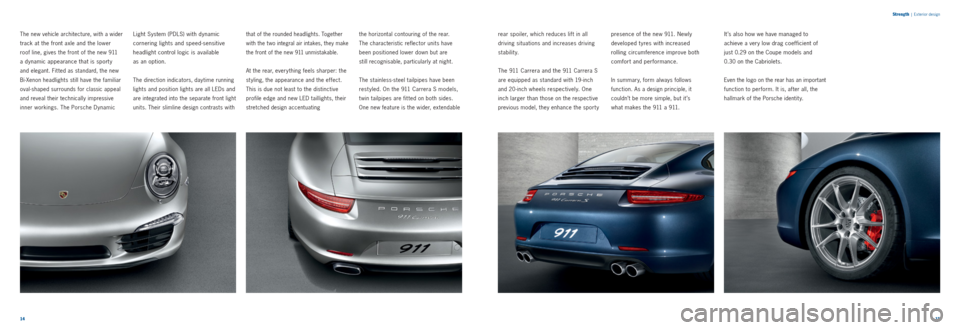
1415
S
treng th
| Exterior design
The new vehicle architecture, with a wider
track at the front axle and the lower
roof line, gives the front of the new 911
a dynamic appearance that is sport y
and elegant. Fit ted as standard, the new
Bi-Xenon headlights still have the familiar
oval-shaped surrounds for classic appeal
and reveal their technically impressive
inner workings. The Porsche Dynamic
Light System (PDLS) with dynamic
cornering lights and speed-sensitive
headlight control logic is available
as an option.
The direction indicators, daytime running
lights and position lights are all LEDs and
are integrated into the separate front light
units. Their slimline design contrasts with
that of the rounded headlights. Together
with the two integral air intakes, they make
the front of the new 911 unmistakable.
At the rear, every thing feels sharper: the
styling, the appearance and the effect.
This is due not least to the distinctive
profile edge and new LED taillights, their
stretched design accentuating the horizontal contouring of the rear.
The characteristic reflector units have
been positioned lower down but are
still recognisable, particularly at night.
The stainless-steel tailpipes have been
rest yled. On the 911 Carrera S models,
t win tailpipes are fit ted on both sides.
One new feature is the wider, extendable rear spoiler, which reduces lift in all
driving situations and increases driving
stability.The 911 Carrera and the 911 Carrera S
are equipped as standard with 19-inch
and 20 -inch wheels
respectively. One
inch larger than
those on the respective
previous model, they enhance the sport y
presence of the new 911. Newly
developed t yres with increased
rolling circumference improve both
comfort and performance.
In summary, form always follows
function. As a design principle, it
couldn’t be more simple, but it ’s
what makes the 911 a 911. It ’s also how we have managed to
achieve a very low drag coefficient of
just 0.29 on the Coupe models and
0.30 on the Cabriolets.
Even the logo on the rear has an important
function to perform. It is, after all, the
hallmark of the Porsche identity.
Page 8 of 67

1617
Strength
|
Interior design
Sporty ergonomics for ordinary driving.
Extraordinary comfort for sporty driving.
Interior design.
At Porsche, we don’t build everyday
sports cars, we build sports cars for every -
day use. How? By understanding that
great agilit y and maximum comfort are
not mutually exclusive but are, in fact,
aspects of a harmonious overall concept.
This is especially true of the interior
of the new 911. Sportiness, functionality
and high qualit y materials combine to
form a cohesive whole that is conducive
to dynamic driving, even during everyday
use.
What this means becomes clear the
moment you get in. The extended wheel -
base now offers 25 mm more leg room
in the front than in previous 911 models. Sportiness in harmony with comfort is
the theme which is reflected in the clever
ergonomics that characterise the entire
interior design. The materials used, the
layout of the controls and their operating
logic belong to a new generation of
sports car. Another new design for the
new 911 is the elevated centre console.
Its intelligent operating concept follows
a clear principle of direct simplicity.
A classic 911 feature is the arrangement
of the five circular instruments with the
rev counter in the middle. A new addition
is the instrument cluster featuring a high-
resolution 4.6-inch full VGA TFT colour
display for viewing on-board computer,
audio system or navigation information. Fit ted as standard, the Sports seats
combine even greater comfort with
racing-st yle support and now feature
4 -way electric adjustment. The new
automatic climate control with zonal
temperature controls for driver and
front passenger also comes as standard.
Also new is the optional light design
package for the foot wells, storage
compartments, rear compartment and
overhead console. As ever, we offer
an extensive selection of interior colours
and materials, such as carbon, leather,
wood or aluminium.
Acoustics are an integral part of the
concept, particularly the engine sound.
Available as an option is the Burmester
®
High-End Surround Sound System.
Optimised for the new 911 Carrera model
range, it features 12 loudspeakers and
a total output of 821 wat ts for a perfect
spatial sound.
The new 911 proves that apparent oppo -
sites, such as st yle and engineering or
comfort and performance, can go hand
in hand. For us, there is no contradiction
and certainly no need for compromise.
After all, a strong personalit y does not
deny the existence of opposites, it unites
them.
Page 9 of 67
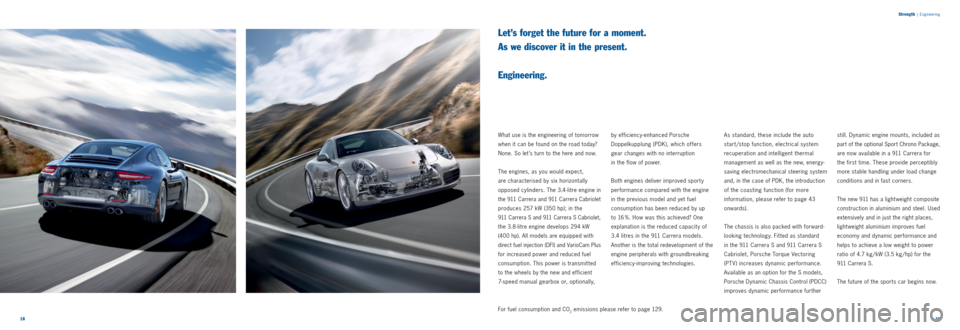
1819
Strength
|
Engineering
Let’s forget the future for a moment.
As we discover it in the present.
Engineering.
What use is the engineering of tomorrow
when it can be found on the road today?
None. So let ’s turn to the here and now.
The engines, as you would expect,
are characterised by six horizontally
opposed cylinders. The 3.4-litre engine in
the 911 Carrera and 911 Carrera Cabriolet
produces 257 kW (350 hp); in the
911 Carrera S and 911 Carrera S Cabriolet,
the 3.8-litre engine develops 294 kW
(400 hp). All models are equipped with
direct fuel injection (DFI) and VarioCam Plus
for increased power and reduced fuel
consumption. This power is transmit ted
to the wheels by the new and efficient
7-speed manual gearbox or, optionally, by efficiency-enhanced Porsche
Doppel kupplung (PDK), which offers
gear changes with no interruption
in the flow of power.
Both engines deliver improved sport y
performance compared with the engine
in the previous model and yet fuel
consumption has been reduced by up
to 16 %. How was this achieved? One
explanation is the reduced capacit y of
3.4 litres in the 911 Carrera models.
Another is the total redevelopment of the
engine peripherals with groundbreaking
efficiency-improving technologies. As standard, these include the auto
start/stop function, electrical system
recuperation and intelligent thermal
management as well as the new, energy-
saving electromechanical steering system
and, in the case of PDK, the introduction
of the coasting function (for more
information, please refer to page 43
onwards).
The chassis is also packed with forward-
looking technology. Fitted as standard
in the 911 Carrera S and 911 Carrera S
Cabriolet, Porsche Torque Vectoring
(PTV) increases dynamic performance.
Available as an option for the S models,
Porsche Dynamic Chassis Control (PDCC)
improves dynamic performance further still. Dynamic engine mounts, included as
part of the optional Sport Chrono Package,
are now available in a 911 Carrera for
the first time. These provide perceptibly
more stable handling under load change
conditions and in fast corners.
The new 911 has a light weight composite
construction in aluminium and steel. Used
extensively and in just the right places,
lightweight aluminium improves fuel
economy and dynamic performance and
helps to achieve a low weight to power
ratio of 4.7 kg / kW (3.5 kg / hp) for the
9 11 C a r r e r a S .
The future of the sports car begins now.
For fuel consumption and CO
2 emissions please refer to page 129.
Page 10 of 67
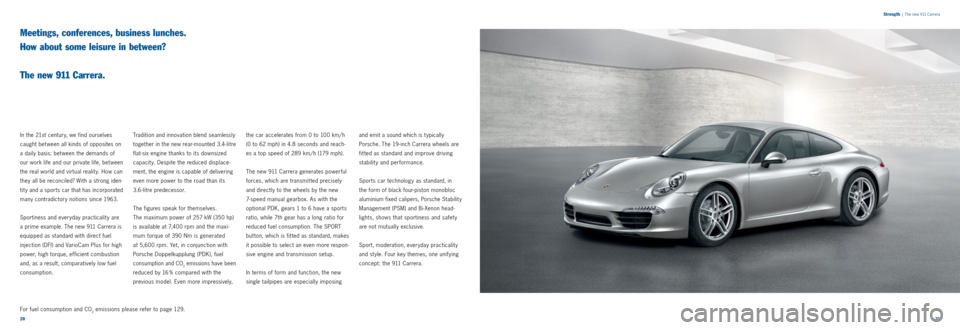
2021
Strength
| The new 911 Carrera
Meetings, conferences, business lunches.
How about some leisure in between?
The new 911 Carrera.
In the 21st century, we find ourselves
caught bet ween all kinds of opposites on
a daily basis: bet ween the demands of
our work life and our private life, between
the real world and virtual realit y. How can
they all be reconciled? With a strong iden -
tit y and a sports car that has incorporated
many contradictory notions since 1963.
Sportiness and everyday practicality are
a prime example. The new 911 Carrera is
equipped as standard with direct fuel
injection (DFI) and VarioCam Plus for high
power, high torque, ef ficient combustion
and, as a result, comparatively low fuel
consumption. Tradition and innovation blend seamlessly
together in the new rear-mounted 3.4-litre
flat-six engine thanks to its downsized
capacity. Despite the reduced displace
-
ment, the engine is capable of delivering
even more power to the road than its
3.6-litre predecessor.
The figures speak for themselves.
The maximum power of 257 kW (350 hp)
is available at 7,400 rpm and the maxi -
mum torque of 390 Nm is generated
at 5,600 rpm. Yet, in conjunction with
Porsche Doppelkupplung (PDK), fuel
consumption and CO2 emissions have been
reduced by 16 % compared with the
previous model. Even more impres
sively,
the car accelerates from 0 to 100 km/ h
(0 to 62 mph) in 4.8 seconds and reach -
es a top speed of 289 km/ h (179 mph).
The new 911 Carrera generates powerful
forces, which are transmit ted precisely
and directly to the wheels by the new
7-speed manual gearbox. As with the
optional PDK, gears 1 to 6 have a sports
ratio, while 7th gear has a long ratio for
reduced fuel consumption. The SPORT
but ton, which is fit ted as standard, makes
it possible to select an even more respon -
sive engine and transmission setup.
In terms of form and function, the new
single tailpipes are especially imposing and emit a sound which is t ypically
Porsche. The 19-inch Carrera wheels are
fit ted as standard and improve driving
stability and performance.
Sports car technology as standard, in
the form of black four-piston monobloc
aluminium fixed calipers, Porsche Stability
Management (PSM) and Bi-Xenon head -
lights, shows that sportiness and safety
are not mutually exclusive.
Sport, moderation, everyday practicality
and st yle. Four key themes, one unifying
concept: the 911 Carrera.
For fuel consumption and CO
2 emissions please refer to page 129.
Page 11 of 67
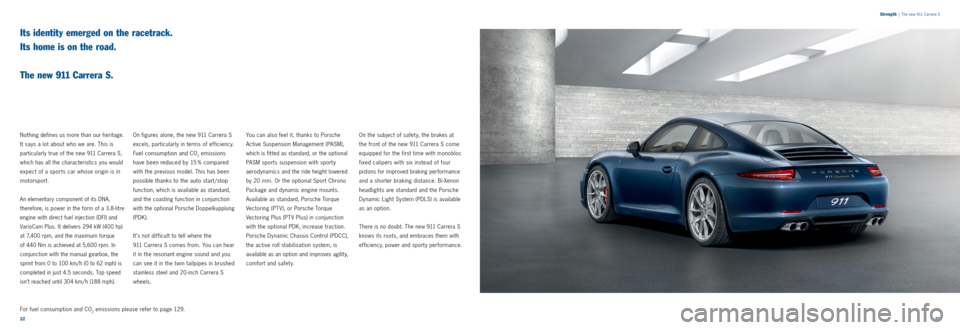
2223
Strength
| The new 911 Carrera S
Its identity emerged on the racetrack.
Its home is on the road.
The new 911 Carrera S.
Nothing defines us more than our heritage.
It says a lot about who we are. This is
particularly true of the new 911 Carrera S,
which has all the characteristics you would
expect of a sports car whose origin is in
motorsport.
An elementary component of its DNA,
therefore, is power in the form of a 3.8-litre
engine with direct fuel injection (DFI) and
VarioCam Plus. It delivers 294 kW (400 hp)
at 7,400 rpm, and the maximum torque
of 440 Nm is achieved at 5,600 rpm. In
conjunction with the manual gearbox, the
sprint from 0 to 100 km/h (0 to 62 mph) is
completed in just 4.5 seconds. Top speed
isn’t reached until 304 km/ h (188 mph).
On figures alone, the new 911 Carrera S
excels, particularly in terms of efficiency.
Fuel consumption and CO2 em issio ns
have been reduced by 15 % compared
with the previous model. This has been
possible thanks to the auto start /stop
function, which is available as standard,
and the coasting function in conjunction
with the optional Porsche Doppelkupplung
(PDK).
It ’s not difficult to tell where the
911 Carrera S comes from. You can hear
it in the resonant engine sound and you
can see it in the t win tailpipes in brushed
stainless steel and 20 - inch Carrera S
wheels. You can also feel it, thanks to Porsche
Active Suspension Management (PASM),
which is fit ted as standard, or the optional
PASM sports suspension with sport y
aerodynamics and the ride height lowered
by 20 mm. Or the optional Sport Chrono
Package and dynamic engine mounts.
Available as standard, Porsche Torque
Vectoring (PTV), or Porsche Torque
Vectoring Plus (PTV Plus) in conjunction
with the optional PDK, increase traction.
Porsche Dynamic Chassis Control (PDCC),
the active roll stabilisation system, is
available as an option and improves agility,
comfort and safet y. On the subject of safet y, the brakes at
the front of the new 911 Carrera S come
equipped for the first time with monobloc
fixed calipers with six instead of four
pistons for improved braking performance
and a shorter braking distance. Bi-Xenon
headlights are standard and the Porsche
Dynamic Light System (PDLS) is available
as an option.
There is no doubt. The new 911 Carrera S
knows its roots, and embraces them with
efficiency, power and sporty performance.
For fuel consumption and CO2 emissions please refer to page 129.
Page 12 of 67
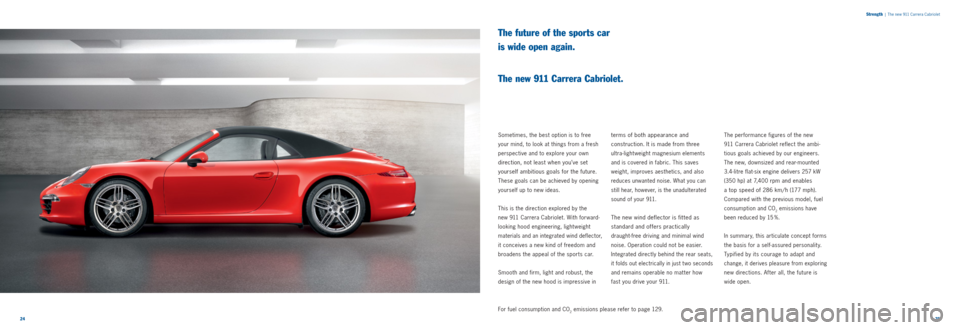
2425
Strength
| The new 911 Carrera Cabriolet
The future of the sports car
is wide open again.
The new 911 Carrera Cabriolet.
Sometimes, the best option is to free
your mind, to look at things from a fresh
perspective and to explore your own
direction, not least when you’ve set
yourself ambitious goals for the future.
These goals can be achieved by opening
yourself up to new ideas.
This is the direction explored by the
new 911 Carrera Cabriolet. With forward-
looking hood engineering, lightweight
materials and an integrated wind deflector,
it conceives a new kind of freedom and
broadens the appeal of the sports car.
Smooth and firm, light and robust, the
design of the new hood is impressive in
terms of both appearance and
construction. It is made from three
ultra-lightweight magnesium elements
and is covered in fabric. This saves
weight, improves
aesthetics, and also
reduces unwanted noise. What you can
still hear, however, is the unadulterated
sound of your 911.
The new wind deflector is fit ted as
standard and offers practically
draught-free driving and minimal wind
noise. Operation could not be easier.
Integrated directly behind the rear seats,
it folds out electrically in just t wo seconds
and remains operable no mat ter how
fast you drive your 911. The performance figures of the new
911 Carrera Cabriolet reflect the ambi -
tious goals achieved by our engineers.
The new, downsized and rear-mounted
3.4-litre flat-six engine delivers 257 kW
(350 hp) at 7,400 rpm and enables
a top speed of 286 km/ h (177 mph).
Compared with the previous model, fuel
consumption and CO
2 emissions have
been reduced by 15 %.
In summary, this articulate concept forms
the basis for a self-assured personalit y.
Typified by its courage to adapt and
change, it derives pleasure from exploring
new directions. After all, the future is
wide open.
For fuel consumption and CO
2 emissions please refer to page 129.
Page 13 of 67
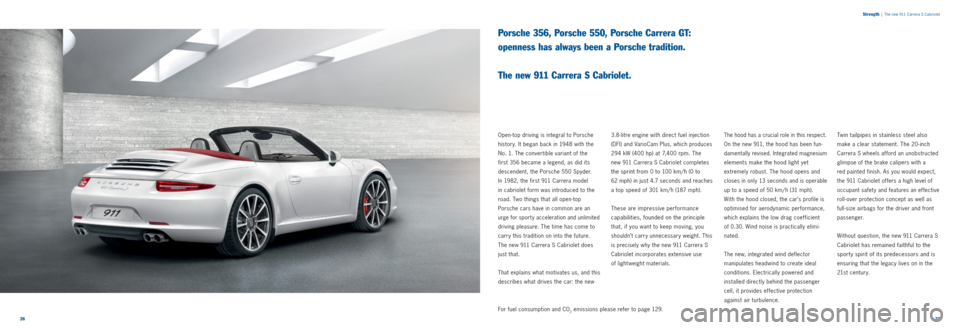
2627
Strength
| The new 911 Carrera S Cabriolet
Porsche 356, Porsche 550, Porsche Carrera GT:
openness has always been a Porsche tradition.
The new 911 Carrera S Cabriolet.
Open-top driving is integral to Porsche
history. It began back in 1948 with the
No. 1. The convertible variant of the
first 356 became a legend, as did its
descendent, the Porsche 550 Spyder.
In 1982, the first 911 Carrera model
in cabriolet form was introduced to the
road. Two things that all open-top
Porsche cars have in common are an
urge for sport y acceleration and unlimited
driving pleasure. The time has come to
carry this tradition on into the future.
The new 911 Carrera S Cabriolet does
just that.
That explains what motivates us, and this
describes what drives the car: the new 3.8-litre engine with direct fuel injection
(DFI) and VarioCam Plus, which produces
294 kW (400 hp) at 7,400 rpm. The
new 911 Carrera S Cabriolet completes
the sprint from 0 to 100 km/ h (0 to
62 mph) in just
4.7 seconds and reaches
a top speed of 301 km/ h (187 mph).
These are impressive performance
capabilities, founded on the principle
that, if you want to keep moving, you
shouldn’t carry unnecessary weight. This
is precisely why the new 911 Carrera S
Cabriolet incorporates extensive use
of lightweight materials.
The hood has a crucial role in this respect.
On the new 911, the hood has been fun -
damentally revised. Integrated magnesium
elements make the hood light yet
extremely robust. The hood opens and
closes in only 13 seconds and is operable
up to a speed of 50 km/ h (31 mph).
With the hood closed, the car’s profile is
optimised for
aerodynamic performance,
which explains
the low drag coefficient
of 0.30. Wind noise is practically elimi -
nated.
The new, integrated wind deflector
manipulates headwind to create ideal
conditions. Electrically powered and
installed directly behind the passenger
cell, it provides effective protection
against air turbulence.
Twin tailpipes in stainless steel also
make a clear statement. The 20 -inch
Carrera S wheels afford an unobstructed
glimpse of the brake calipers with a
red painted finish. As you would expect,
the 911 Cabriolet offers a high level of
occupant safet y and features an effective
roll-over protection concept as well as
full-size airbags for the driver and front
p a s s e n g e r.
Without question, the new 911 Carrera S
Cabriolet has remained faithful to the
sporty spirit of its predecessors and is
ensuring that the legacy lives on in the
21s t ce n t u r y.
For fuel consumption and CO
2 emissions please refer to page 129.
Page 15 of 67

3031
Temperament
|
Engines
To give more and take less.
That’s Porsche engineering.
Engines.
You could ask whether the sports car is
still relevant. It would be a good question,
but you might as well ask the same of
dreams.
The answer to both questions lies in
the future or, to be more precise, in the
future of the sports car. In the new 911,
the future has already begun. The highly
ef ficient, state - of-the -art engines make
a considerable contribution to reducing
fuel consumption, but their sound is still
unmistakably Porsche. The new 911 engines are also unmistaka
-
bly sport y thanks to the new SPORT
but ton fit ted as standard. At the push
of a button, the engine becomes tuned
for a sharper response and engine
dynamics that are even more direct.
The 3.4-litre engine of the new
911 Carrera models demonstrates, there -
fore, that performance and efficiency
need not be mutually exclusive. Rather,
the downsized engine capacit y and
increased maximum torque are the intelli -
gent basis by which power output
can be increased in an environmentally
acceptable and sustainable way. Fuel consumption and CO
2 emissions have
been reduced by up to 16 % compared
with the previous model.
In their search for improved efficiency,
our engineers analysed an extensive series
of engine components. Answers were
found, including rapid heating of the
engine and gearbox to normal operating
temperature after an engine start by
the new thermal management system,
improved air induction and the extremely
effective direct fuel injection (DFI).
The same principle applies to the 3.8-litre
engine in the 911 Carrera S models. There has been no change in displacement
since the previous model, but power
output has been increased while fuel
consumption has been reduced by up
to 15 % .
Weight is critical to efficiency. This is
why the engines have a light-alloy
construction, which makes them light -
weight and structurally rigid for improved
fuel economy and a long life.
The engine is the intelligent core of our
identit y. What else could the ‘Dr. Ing.’ in
our company name possibly stand for?
For fuel consumption and CO
2 emissions please refer to page 129.
Page 17 of 67
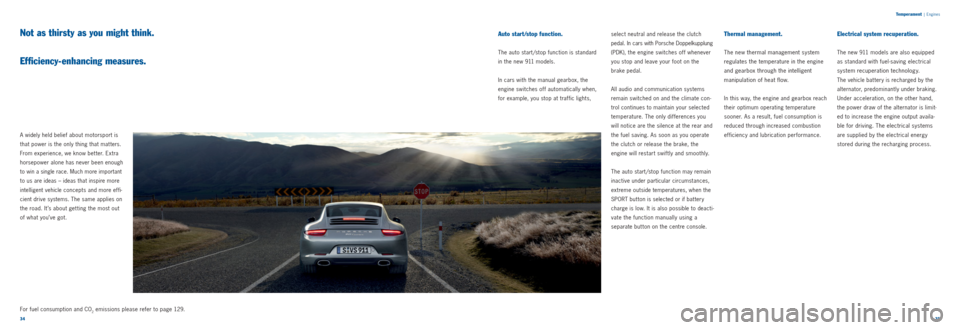
3435
A widely held belief about motorsport is
that power is the only thing that mat ters.
From experience, we know bet ter. Extra
horsepower alone has never been enough
to win a single race. Much more important
to us are ideas – ideas that inspire more
intelligent vehicle concepts and more ef fi-
cient drive systems. The same applies on
the road. It ’s about get ting the most out
of what you’ve got. select neutral and release the clutch
pedal. In cars with Porsche Doppel
kupplung
(PDK), the engine switches off whenever
you stop and leave your foot on the
brake pedal.
All audio and communication systems
remain switched on and the climate con -
trol continues to maintain your selected
temperature. The only differences you
will notice are the silence at the rear and
the fuel saving. As soon as you operate
the clutch or release the brake, the
engine will restart swiftly and smoothly.
The auto start/stop function may remain
inactive under particular circumstances,
extreme outside temperatures, when the
SPORT but ton is selected or if bat tery
charge is low. It is also possible to deacti -
vate the function manually using a
separate but ton on the centre console.
Thermal management.
The new thermal management system
regulates the temperature in the engine
and gearbox through the intelligent
manipulation of heat flow.
In this way, the engine and gearbox reach
their optimum operating temperature
sooner. As a result, fuel consumption is
reduced through increased combustion
efficiency and lubrication performance.
Electrical system recuperation.
The new 911 models are also equipped
as standard with fuel-saving electrical
system recuperation technology.
The vehicle bat tery is recharged by the
alternator, predominantly under braking.
Under acceleration, on the other hand,
the power draw of the alternator is limit -
ed to increase the engine output availa -
ble for driving. The electrical systems
are supplied by the electrical energy
stored during the recharging process.
Temperament | Engines
Auto start/stop function.
The auto start/stop function is standard
in the new 911 models.
In cars with the manual gearbox, the
engine switches off automatically when,
for example, you stop at traffic lights,
Not as thirsty as you might think.
Efficiency- enhancing measures.
For fuel consumption and CO2 emissions please refer to page 129.